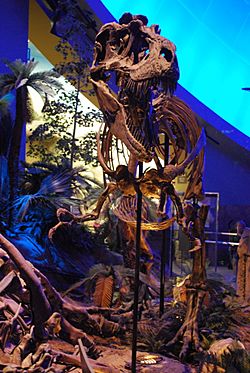Gorgosaurus facts for kids
Quick facts for kids GorgosaurusTemporal range: Upper Cretaceous
|
|
|---|---|
 |
|
| Gorgosaurus skeletal mount | |
| Scientific classification | |
| Kingdom: | |
| Phylum: | |
| Class: | |
| Superorder: | |
| Order: | |
| Suborder: | |
| Family: | |
| Genus: |
†Gorgosaurus
Lambe, 1914
|
| Species | |
|
|
Gorgosaurus, meaning "fierce lizard", is a genus of tyrannosaurid theropod dinosaur that lived in western North America between 80 and 73 million years ago, during the Late Cretaceous Period.
Like most known tyrannosaurids, Gorgosaurus was a multi-ton bipedal predator equipped with dozens of large, sharp teeth; it also bore tiny two-fingered forelimbs typical of its close relatives. Although relatively large for a theropod, Gorgosaurus was much smaller than its more famous relative Tyrannosaurus.
It was first described by paleontologist Lawrence Morris Lambe, in 1914 Since then more than 20 Gorgosaurus skeletons have been recovered, making it the best-represented tyrannosaurid in the fossil record. In some areas, it coexisted with another tyrannosaurid, Daspletosaurus, though there is some evidence of niche differentiation between the two. As an apex predator, Gorgosaurus was at the top of the food chain, probably preying on large dinosaurs like the ceratopsid Centrosaurus and the hadrosaur Hypacrosaurus.
Description
While clearly a large and fearsome animal, Gorgosaurus was nonetheless much smaller than the truly gigantic tyrannosaurids like Tarbosaurus and Tyrannosaurus, and significantly more lightly-built than Daspletosaurus, which it appears to have coexisted with. Adults reached 7 to 8 metres (27 to 30 feet) from snout to tail, with an estimated weight of 2.5 tonnes (2.75 short tons).
It had a massive skull almost a meters (39 inches) long; perched on a short S-shaped neck. Wide openings in the skull (fenestrae) reduced the weight of the head while also providing space for muscle attachment and sensory organs. Gorgosaurus has a more circular orbit than any other tyrannosaurid. It bore large curved teeth, tiny two-fingered front limbs, and powerful legs. Compared to the other tyrannosaurids, Gorgosaurus is most similar to its very close relative Albertosaurus.
Classification and systematics
Gorgosaurus is a member of the theropod family Tyrannosauridae, in the subfamily Albertosaurinae. Its closest relative is the slightly younger Albertosaurus sarcophagus. These two species are the only described albertosaurines, although other undescribed species may exist.
The species G. libratus, the only species of Gorgosaurus currently recognized, was reassigned to Albertosaurus by Russell in his extensive review of the Tyrannosauridae in 1970, which many subsequent authors followed. However, recent work done by Thomas Holtz suggest that enough differences exist between G. libratus and the other Albertosaurus species, to justify the original genus name of Gorgosaurus.
Holtz found Appalachiosaurus to be an albertosaurine in 2004, but his more recent unpublished work locates it just outside Tyrannosauridae, in agreement with other authors.
The other major subfamily of tyrannosaurids is the Tyrannosaurinae, including Daspletosaurus torosus, Tarbosaurus bataar and Tyrannosaurus rex. Compared to these robust tyrannosaurines, albertosaurines had slender builds, with proportionately smaller skulls and longer bones of the lower leg (tibia) and feet (metatarsals and phalanges).
Discovery and naming
It was first described by paleontologist Lawrence Moe in 1914, who named it "fierce lizard" from the Greek gorgos/γορργος meaning "terrible" or "fierce" and saurus/σαυρος meaning "lizard". Fossilized tyrannosaurid teeth of the Late Cretaceous of Montana described as Deinodon by paleontologist Joseph Leidy in 1856, are likely to belong to Gorgosaurus, though it is virtually impossible to distinguish between different tyrannosaurid species based on tooth characteristics alone, so Deinodon is today considered a nomen dubium. Gorgosaurus is known from more complete fossil material than any other tyrannosaurid, with over 20 skeletons recovered. However confirmed material is thus far restricted to the upper Dinosaur Park Formation of the late Campanian of Alberta, though probable fragmentary remains have been found in the Two Medicine and Judith River Formations of Montana and Fruitland and lower Kirtland Formations of New Mexico.
Images for kids
-
Type specimen of Gorgosaurus sternbergi (AMNH 5664), now recognized as a juvenile Gorgosaurus libratus
-
Specimen USNM 12814 (formerly AMNH 5428)
-
Skeletal mount, Children's Museum of Indianapolis
-
Bob Bakker and a skeleton with several bone injuries, from the "Dinosaur Mummy: CSI" exhibit at the HMNS
-
Sub-adult specimen TMP91.36.500 in "death pose", Royal Tyrrell Museum of Palaeontology
-
Cast of specimen ROM 1247
-
Dinosaur Park specimen (FMNH PR308) of Daspletosaurus, mounted at the Field Museum
See also
 In Spanish: Gorgosaurus libratus para niños
In Spanish: Gorgosaurus libratus para niños













